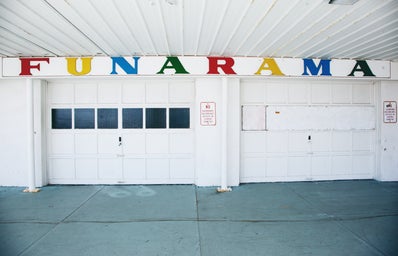Two weeks ago I wrote about the Insta-poetry movement and its necessity in introducing poetry to a wider audience. This week I would like to go beyond poetry that is accessible on social media and showcase a form of poetry often ignored outside of the academic community: conceptual poetry.
Conceptual Poetry can be almost anything as long as there is a predetermined approach the author takes toward writing a work. In the case of Murakami’s Get Me Out Of Here Murakami takes quotes from family and friends in airports either arriving or departing, and writes poetry inspired by those quotes. Oftentimes each poem has its own approach to conceiving it.
In this article I will be focusing on the poem based on the quote “In Newmark, someone has changed the GLASS bottle recycling slots so they now say ASS” (Murakami, 51). The poem that resulted from this quote is divided into 3 sections REDUCE, REUSE, and RECYCLE, and just by looking at these subtitles her inspiration for each section becomes obvious. The quote above resulted in a focus on the 3 ways to readapt and reuse materials, and through this inspiration she creates 3 re-adaptations of the quote above based on each subtitle. I will be using a poem that I wrote in response to this poem using base material from “The Red Wheelbarrow” by William Carlos Williams, as well as quotes from the poem itself in order to represent her approach to creating the work.
In REDUCE she mimics the reduction of GLASS to ASS in the quote above but takes it a step further until only the A is left behind, then a dash, and then nothing at all. GLASS
GLASS
GLASS
LASS
LASS
LASS
ASS
ASS
ASS
AS
AS
AS
A
A
A
_
_
_
_
_
_
_
.
.
.
.
(Murakami 51)
This is repeated 12 times across the page each GLASS linking to the next. As each letter is deleted each set word becomes more and more independent from the next.
In my own approach to Murakami’s use of REDUCE I used the word “glazed” from “The Red Wheelbarrow” and reduced it down to a single letter. Whereas Murakami reduced GLASS down to existing words I wanted to evoke the idea of the sounds the letters make together, and how that changed as each letter was lost.
REDUCE:
glazedglazedglazedglazedglazedglazedglazedglazedglazedglazedglazedglazedglazedglazed
glaze glaze glaze glaze glaze glaze glaze glaze glaze glaze glaze glaze glaze glaze
laze laze laze laze laze laze laze laze laze laze laze laze laze laze
la e la e la e la e la e la e la e la e la e la e la e la e la e la e
la la la la la la la la la la la la la la
a a a a a a a a a a a a a a
In REUSE Murakami creates acronyms out of the initial quote like “Here, Tolstoy’s swans watch / noisy Beyonce shake the angst manger. / O leads the cellos.” (Murakami 52). By taking the letters from the initial quote and refurbishing them to create entirely new phrases Murakami is enacting exactly what reusing represents, the recreation of old materials into something new and extraordinary.
In creating my own version of REUSE I also created acronyms using my base text, but rather than repeated create different acronyms from the same quote I used each stanza of “The Red Wheelbarrow” and created acronyms from each stanza while maintaining a similar structure to the original poem. Like Murakami I reused the letters of my original source, but instead of totally redefining it I hold onto its structure.
REUSE
homespun sodden
cup
bare lewd war
hero
her raw tantalized
wig
she hewed kinetic
bitches.
RECYCLE uses a similar methodology but rather than reuse all the letters in the initial phrase Murakami chooses to recycle specific phrases and words from the quote, reducing the phrase “in Newark someone has changed.” (Murakami 53) to “Some New”, (Murakami 53). This emphasizes the idea of recreating or taking bits of an object (or in this case quote) in order to recycle and reduce the initial materials into something entirely new.
In mimicking RECYCLE I choose not to reduce and recreate one specific phrase or part of “The Red Wheelbarrow” as Murakami did with her quote. Instead, I tried to recycle and reorder individual phrases from “The Red Wheelbarrow” into something far from the mood of “The Red Wheelbarrow”.
RECYCLE
so much
depends
depends upon,
white glazed
chickens
red with
rain.
Every portion of the poem seeks to create something out of only the quotation she was given, similar to how we reduce, reuse, and recycle materials in order to remanufacture them for future use in our own lives. The quote is similar to any material that we would throw into the recycling bin, a material that can become something so much more than a can of pop, or a water bottle. This poem shows us that in poetry a base material can be anything, a poem, a common saying, a joke. REDUCE, REUSE and RECYCLE represent exactly how our interactions with poetry allow us to respond to, reuse (in our own way), and grow from the words and techniques we encounter every day.
While I did not include the entire poem in this article I would strongly suggest looking into Murakami’s work. Her book Get Me Out Of Here is available on talonbooks.com, and she has a website at http://www.sachikomurakami.com.
All quotes included in this come from the 2015 Talonbooks publication of Get Me Out of Here by Sachiko Murakami.


